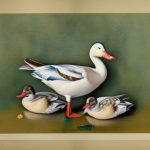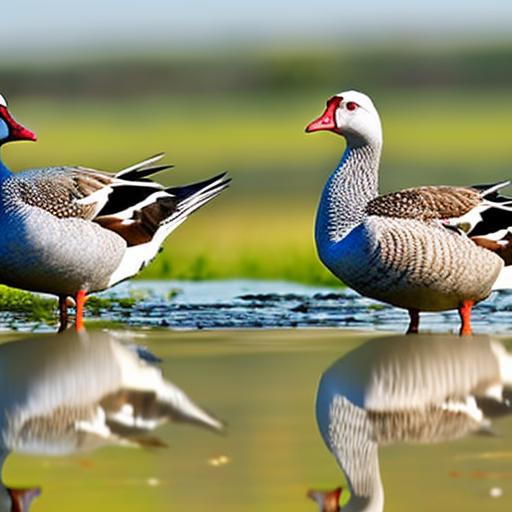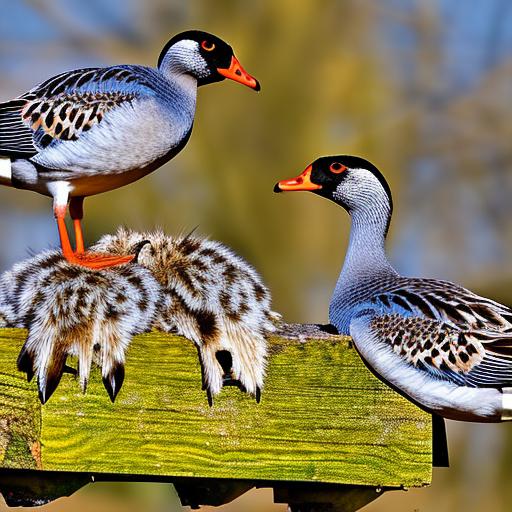Large duck breeds are a popular choice for many farmers and homesteaders due to their impressive size, meat production, and egg-laying capabilities. These breeds are known for their robust nature and adaptability to various climates, making them a valuable addition to any farm or backyard setting. Large duck breeds are also favored for their calm and friendly demeanor, making them an ideal choice for those looking to raise ducks for both production and companionship.
Large duck breeds come in a variety of colors and patterns, adding a beautiful and diverse aesthetic to any flock. Whether you are looking to raise ducks for meat, eggs, or simply as pets, large duck breeds offer a wide range of benefits and opportunities for those interested in poultry farming. In this article, we will explore the characteristics, popular breeds, housing and care requirements, as well as the benefits and challenges of raising large duck breeds. By the end of this article, you will have a comprehensive understanding of what it takes to successfully raise and care for large duck breeds.
Table of Contents
Key Takeaways
- Large duck breeds are known for their size and meat production, making them popular for both meat and egg production.
- Characteristics of large duck breeds include a heavy body, strong legs, and a calm temperament, making them suitable for free-range or backyard farming.
- Popular large duck breeds include the Pekin, Muscovy, and Rouen, each with their own unique characteristics and advantages.
- Housing and care for large duck breeds require spacious and secure enclosures, access to water for swimming, and a balanced diet to support their growth and health.
- Raising large duck breeds can provide benefits such as high meat and egg production, pest control, and a sustainable source of income, but it also comes with challenges such as space requirements and potential health issues.
Characteristics of Large Duck Breeds
Large duck breeds are known for their impressive size, with males often weighing between 8-12 pounds and females ranging from 7-10 pounds. These breeds are also recognized for their strong and sturdy build, making them well-suited for meat production. In addition to their size, large duck breeds are also valued for their high egg-laying capabilities, with some breeds laying up to 200 eggs per year.
Large duck breeds are known for their calm and friendly temperament, making them easy to handle and interact with. They are also highly adaptable to various climates and can thrive in both free-range and confined settings. These breeds are also recognized for their excellent foraging abilities, making them efficient at finding their own food when given access to outdoor spaces.
In terms of appearance, large duck breeds come in a wide range of colors and patterns, adding a beautiful and diverse aesthetic to any flock. From the striking white plumage of the Pekin duck to the stunning blue and black markings of the Swedish duck, large duck breeds offer a visually appealing addition to any farm or backyard setting.
Popular Large Duck Breeds
There are several popular large duck breeds that are favored by farmers and homesteaders for their size, productivity, and adaptability. One of the most well-known large duck breeds is the Pekin duck, which is prized for its rapid growth rate, meat production, and calm demeanor. The Pekin duck is easily recognizable by its pure white plumage and orange bill, making it a popular choice for both commercial and backyard farming.
Another popular large duck breed is the Rouen duck, which is valued for its striking resemblance to the wild Mallard duck. The Rouen duck is known for its large size, excellent meat quality, and beautiful iridescent green plumage. This breed is also recognized for its calm and friendly nature, making it a great choice for those looking to raise ducks for both production and companionship.
The Cayuga duck is another popular large breed known for its stunning iridescent green and black plumage. This breed is valued for its high egg-laying capabilities, with females laying up to 150-200 eggs per year. The Cayuga duck is also recognized for its calm temperament and adaptability to various climates, making it a versatile choice for poultry farming.
Other popular large duck breeds include the Swedish duck, Saxony duck, and Silver Appleyard duck, each offering unique characteristics and benefits for those interested in raising ducks for meat, eggs, or as pets.
Housing and Care for Large Duck Breeds
When it comes to housing and caring for large duck breeds, there are several important considerations to keep in mind. Large ducks require ample space to roam and forage, so it is important to provide a spacious outdoor area or access to free-range pasture. A secure enclosure is also essential to protect ducks from predators and provide shelter from the elements.
Large ducks also require access to clean water for drinking and bathing, so it is important to provide a pond or shallow water source for them to enjoy. Additionally, ducks should be provided with a balanced diet that includes a mix of commercial feed, fresh greens, and access to insects and other natural forage.
Regular health checks and preventative care are also important when raising large duck breeds. This includes monitoring for signs of illness or injury, providing regular access to clean water and nutritious feed, and ensuring that ducks have access to appropriate shelter and protection from extreme weather conditions.
Benefits of Raising Large Duck Breeds
There are numerous benefits to raising large duck breeds on your farm or homestead. One of the primary benefits is their impressive size and meat production capabilities. Large duck breeds such as the Pekin and Rouen ducks are valued for their rapid growth rate and high-quality meat, making them a valuable addition to any meat production operation.
In addition to meat production, large duck breeds are also valued for their high egg-laying capabilities. Breeds such as the Cayuga and Swedish ducks are known for their prolific egg production, making them a valuable source of fresh eggs for consumption or sale.
Large duck breeds are also recognized for their calm and friendly demeanor, making them an ideal choice for those looking to raise ducks as pets or for companionship. Their adaptability to various climates and strong build make them well-suited for outdoor living, whether in free-range or confined settings.
Furthermore, large duck breeds offer a visually appealing addition to any farm or backyard setting, with a wide range of colors and patterns to choose from. Whether you are looking to raise ducks for meat, eggs, or simply as pets, large duck breeds offer a diverse range of benefits and opportunities for those interested in poultry farming.
Challenges of Raising Large Duck Breeds

While there are numerous benefits to raising large duck breeds, there are also some challenges that should be considered. One challenge is the space required to accommodate their size and need for outdoor roaming. Large ducks require ample space to roam and forage, so it is important to provide a spacious outdoor area or access to free-range pasture.
Another challenge is the need for secure housing and protection from predators. Large ducks are vulnerable to predators such as foxes, raccoons, and birds of prey, so it is important to provide a secure enclosure and take measures to protect them from potential threats.
Health care and maintenance can also be a challenge when raising large duck breeds. Regular health checks, preventative care, and access to clean water and nutritious feed are essential for maintaining the health and well-being of large ducks.
Additionally, large ducks can be messy when it comes to water and mud, so it is important to consider the maintenance required to keep their living area clean and sanitary.
Conclusion and Recommendations for Raising Large Duck Breeds
In conclusion, raising large duck breeds offers a wide range of benefits and opportunities for those interested in poultry farming. From their impressive size and meat production capabilities to their high egg-laying capabilities and friendly demeanor, large duck breeds are a valuable addition to any farm or homestead.
When considering raising large duck breeds, it is important to carefully consider their housing and care requirements, as well as the potential challenges that may arise. Providing ample space for outdoor roaming, secure housing protection from predators, regular health checks, preventative care, access to clean water and nutritious feed are essential components of successfully raising large duck breeds.
Overall, with proper care and attention, raising large duck breeds can be a rewarding experience that offers a valuable source of meat, eggs, or companionship on your farm or homestead. Whether you are looking to raise ducks for production or simply as pets, large duck breeds offer a diverse range of benefits that make them a valuable addition to any poultry farming operation.
If you’re interested in large duck breeds, you might also want to check out this article on the incubation period for goose eggs. Understanding the incubation process is crucial for anyone looking to breed waterfowl, and this article provides valuable insights into the topic.
FAQs
What are some examples of large duck breeds?
Some examples of large duck breeds include the Pekin, Muscovy, Rouen, Aylesbury, and Swedish Blue.
What are the characteristics of large duck breeds?
Large duck breeds are known for their size, with males typically weighing between 8-12 pounds and females weighing between 7-10 pounds. They also have a broad, deep body and a wide, flat bill.
What are the purposes of raising large duck breeds?
Large duck breeds are often raised for meat production due to their size and meat quality. They are also popular for their egg production and can be kept as pets or for exhibition purposes.
How do you care for large duck breeds?
Caring for large duck breeds involves providing them with a spacious and secure enclosure, access to water for swimming and drinking, a balanced diet of commercial duck feed and fresh greens, and regular health check-ups.
What are the differences between large duck breeds and smaller duck breeds?
Large duck breeds are generally heavier and have a larger body size compared to smaller duck breeds. They also tend to have a calmer and more docile temperament.
Meet Walter, the feathered-friend fanatic of Florida! Nestled in the sunshine state, Walter struts through life with his feathered companions, clucking his way to happiness. With a coop that’s fancier than a five-star hotel, he’s the Don Juan of the chicken world. When he’s not teaching his hens to do the cha-cha, you’ll find him in a heated debate with his prized rooster, Sir Clucks-a-Lot. Walter’s poultry passion is no yolk; he’s the sunny-side-up guy you never knew you needed in your flock of friends!






